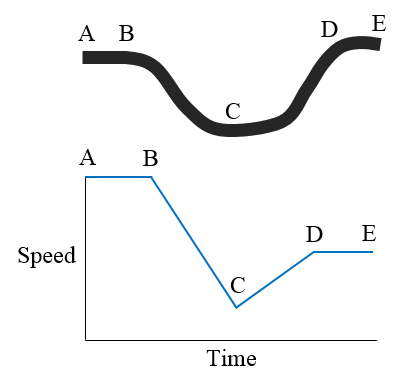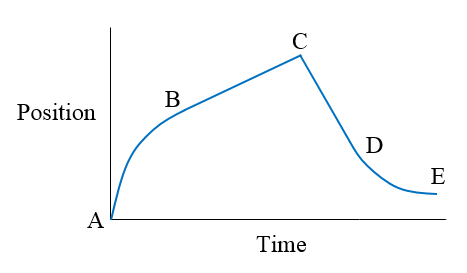Uniform Motion Problems
On this page I put together a collection of uniform motion problems to help you understand uniform motion better. Uniform motion is motion in a straight line at constant velocity.Problem # 1
A train is traveling on a straight section of track at constant speed. In 60 seconds it covers a distance of 1800 meters. What is the speed of the train? Answer: 30 m/s
Problem # 2
A car is traveling down a highway at a speed of 100 km/h. How far does the car travel in 24 minutes? Answer: 40 km
Problem # 3
A car accelerates from 0 to 100 km/h in 10 seconds, and then travels at constant speed. What is the speed of the car after 1 minute? Answer: 100 km/h
Problem # 4
A car travels a distance of d in 60 seconds and a distance of 2d in 120 seconds. At 30 seconds the car has traveled a distance of 650 meters. What is the value of d ? Answer: 1300 meters
Problem # 5
The figure below shows the road that a car travels and the corresponding speed versus time graph for the car. Between which two points is the car experiencing uniform motion?
See answer

Problem # 6
The figure below shows the position versus time graph for a car traveling on a straight road. Between which two points is the car experiencing uniform motion?
See answer

Problem # 7
In the previous problem, at which point does the car change its direction of motion?
See answer
Answers For Uniform Motion Problems
Answer for Problem # 5
For the car to experience uniform motion, it has to move in a straight line AND travel at constant speed. This is only true between the points A and B.
Answer for Problem # 6
The car experiences uniform motion in locations where the slope of the line is constant, which is between points B and C, and between points C and D.
Answer for Problem # 7
At point C, the slope of the line changes, which means that the velocity of the car transitions from positive to negative. This means that the car reverses its travel direction. Note that the cusp at point C is not very realistic. In reality, there would be a more gradual transition in velocity as the slope changes from positive to negative.
Return to Physics Questions page
Return to Real World Physics Problems home page
Free Newsletter
Subscribe to my free newsletter below. In it I explore physics ideas that seem like science fiction but could become reality in the distant future. I develop these ideas with the help of AI. I will send it out a few times a month.